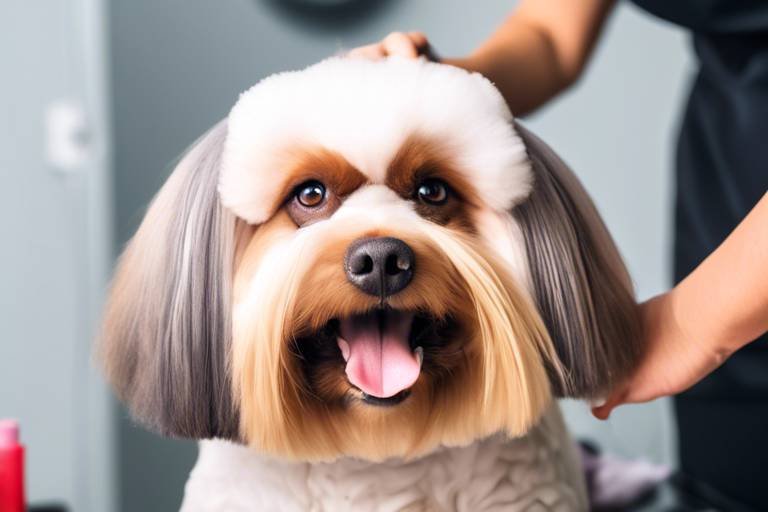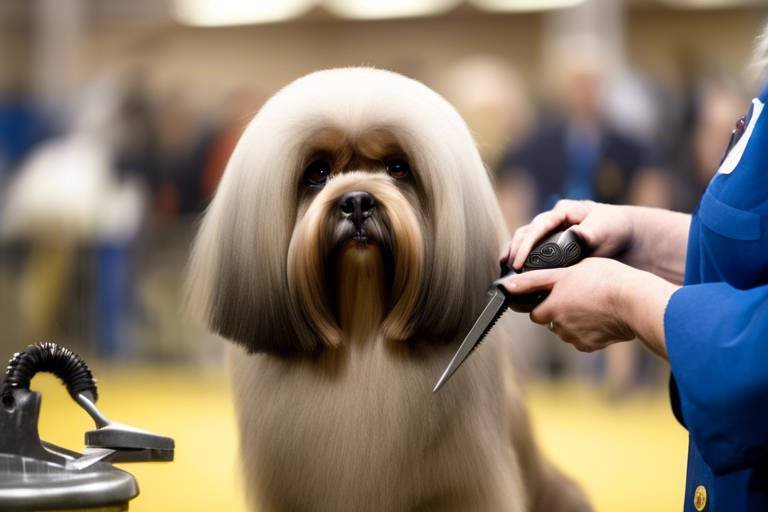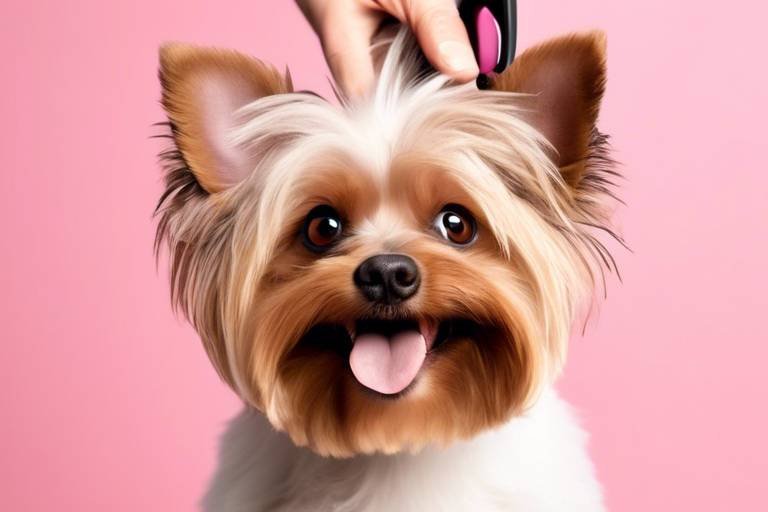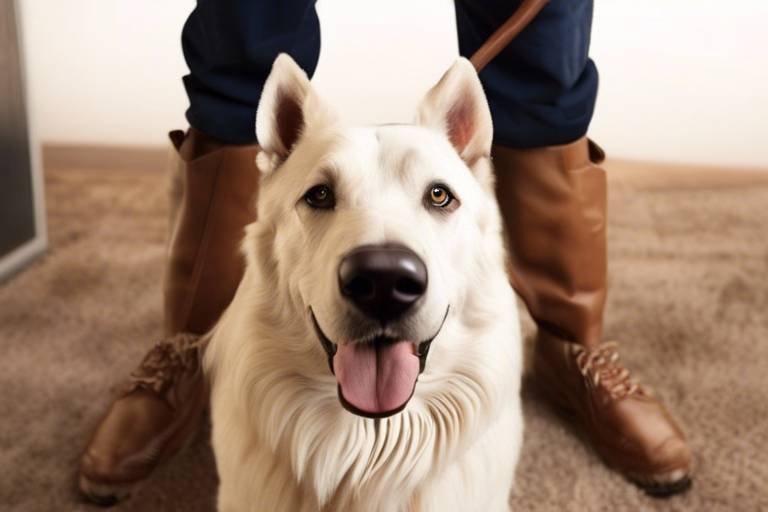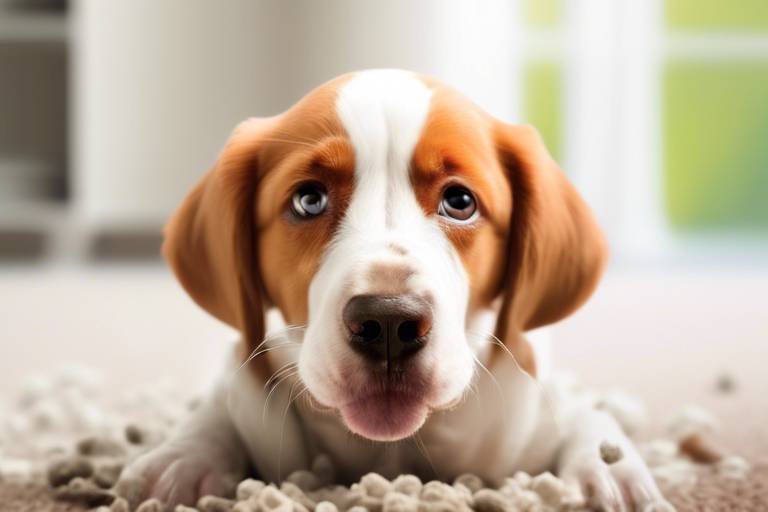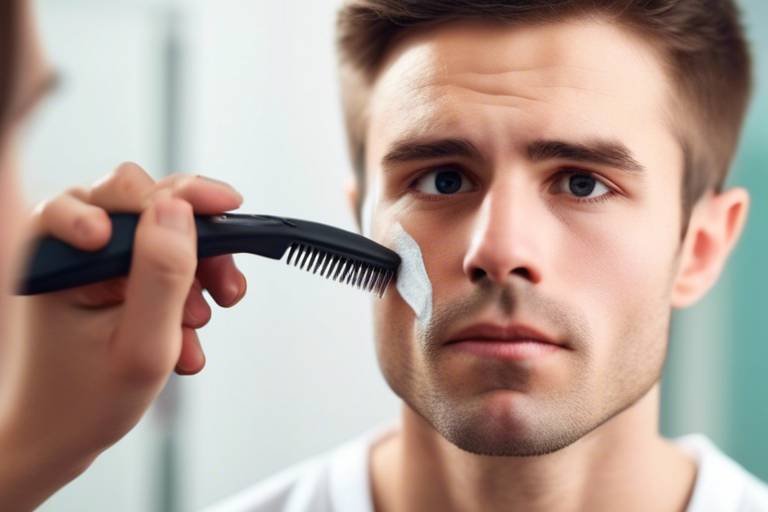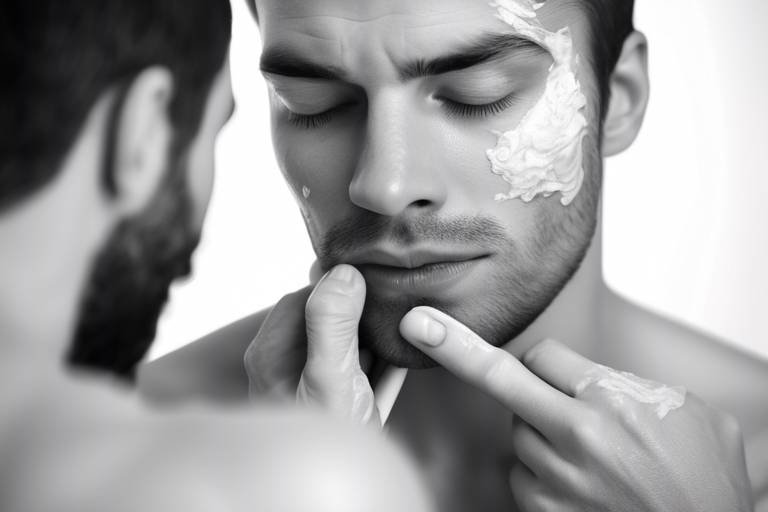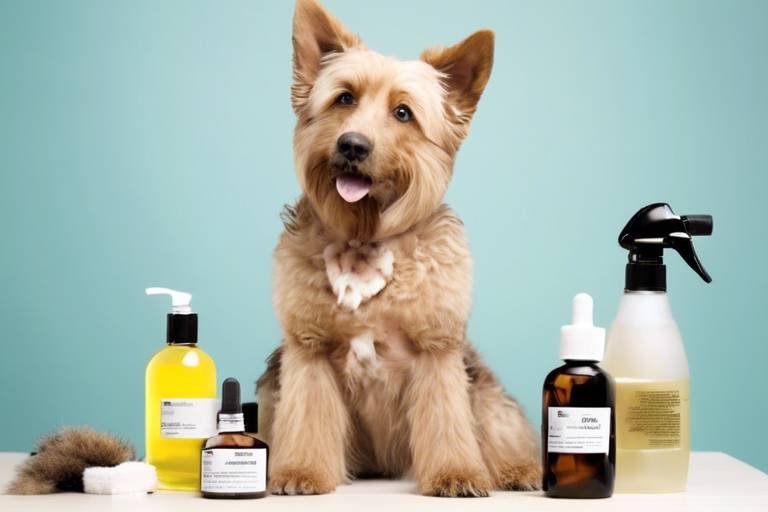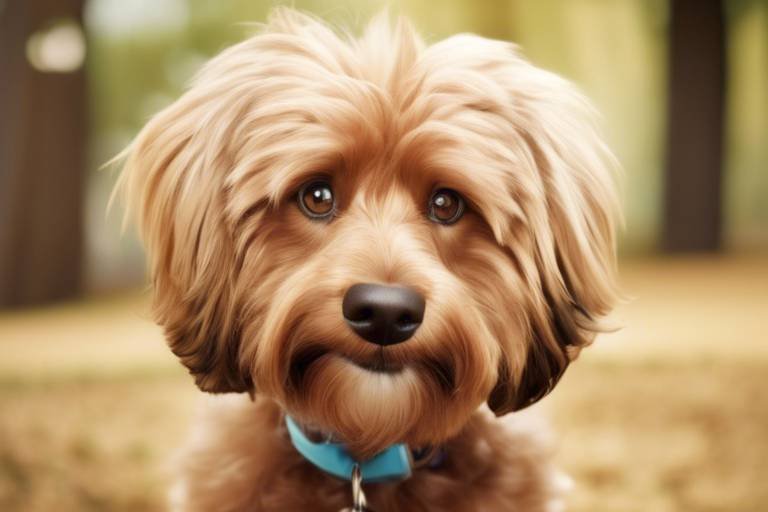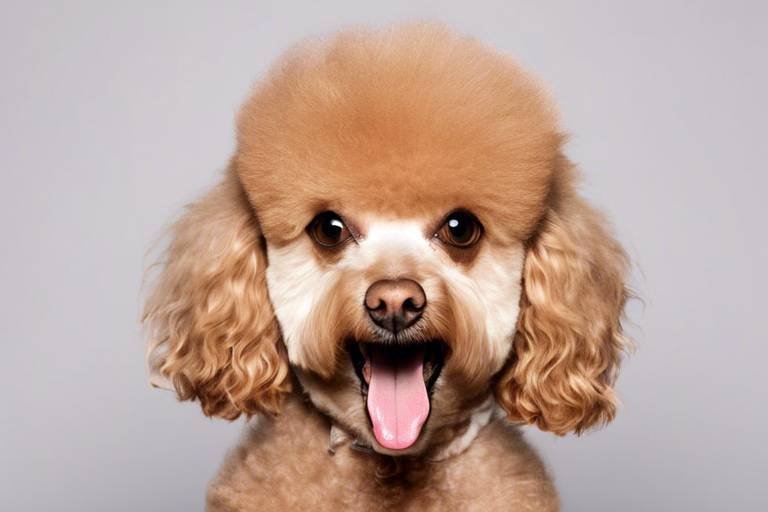How to Help Your Pet Cope with a New Groomer
Transitioning your furry friend to a new groomer can feel like a daunting task, both for you and your pet. Just imagine being thrust into a new environment with unfamiliar sounds, smells, and people. It’s no wonder that many pets experience anxiety during grooming sessions! But fear not; with the right strategies and a bit of preparation, you can help your pet not only cope but thrive during their grooming experience. In this article, we’ll delve into effective ways to ease your pet’s transition, ensuring that their grooming appointments become a positive and stress-free part of their routine.
Before you can help your pet adjust, it’s crucial to understand the signs of anxiety they may exhibit. Pets often communicate their discomfort through various behaviors, such as:
- Excessive barking or whining
- Hiding or trying to escape
- Shaking or trembling
- Loss of appetite or refusal to eat
Recognizing these signs allows you to address your pet’s feelings effectively. For instance, if your dog tends to hide when it’s grooming time, it might be beneficial to create a safe space for them or gradually introduce them to the grooming tools at home. Remember, just like us, pets can feel overwhelmed in new situations, so patience and understanding are key!
Finding the perfect groomer for your pet is essential for a smooth transition. Not all groomers are created equal, and it’s important to consider several factors before making your choice. You’ll want to look for a groomer who not only has the right skills but also understands your pet’s unique needs. Here are some important factors to keep in mind:
- Location and accessibility
- Groomer’s experience and qualifications
- Reviews from other pet owners
- Facility cleanliness and safety measures
Taking the time to research and select the right groomer can make a world of difference in your pet’s grooming experience. It’s worth it to ask around for recommendations or even visit the grooming facility beforehand to see how the staff interacts with the animals.
When it comes to grooming, qualifications matter! A groomer’s credentials can significantly influence the quality of care your pet receives. Look for certifications from recognized grooming schools or organizations, as these can indicate a level of professionalism and expertise. Additionally, don’t hesitate to ask about their ongoing education and training, as the grooming industry is constantly evolving with new techniques and styles.
Did you know that some groomers specialize in particular breeds? This specialization can greatly enhance your pet’s grooming experience. For example, if you have a Poodle, a groomer with experience in Poodle grooming will be more familiar with the specific styles and care needs of that breed. It’s like choosing a chef who specializes in your favorite cuisine—you're more likely to enjoy the meal!
Different groomers use various techniques and tools that can affect your pet's comfort level. When interviewing potential groomers, don’t hesitate to ask about the methods they use. Are they gentle? Do they use calming techniques? Additionally, inquire about the tools they prefer. Some pets may be sensitive to certain sounds or sensations, so understanding the groomer's approach can help you make an informed choice.
Preparation is half the battle when it comes to easing your pet’s anxiety. Before their first grooming appointment, acclimate your pet to the grooming process at home. This could involve:
- Brushing their coat regularly
- Introducing them to grooming tools like clippers and brushes
- Practicing short grooming sessions to build familiarity
These small steps can help your pet associate grooming with positive experiences, making the transition to a new groomer much smoother.
Once you’ve chosen the right groomer and prepared your pet, it’s time to focus on making the grooming experience enjoyable. A positive atmosphere can significantly reduce anxiety, so consider the following strategies:
Positive reinforcement is a powerful tool in helping your pet feel more comfortable during grooming. Use treats and praise to create a positive association with the grooming process. For example, reward your pet with their favorite treat immediately after a successful grooming session or even during the process if they remain calm. This can help them see grooming as a fun and rewarding experience rather than something to fear.
Establishing a consistent grooming routine can also help your pet adjust. Just like us, pets thrive on routine and familiarity. Try to schedule regular grooming appointments, whether it’s every month or every few weeks. This consistency can help your pet feel more secure and reduce anxiety over time. Think of it as a regular spa day—something to look forward to!
Q: How can I tell if my pet is anxious during grooming?
A: Look for signs like excessive barking, hiding, or trembling. If your pet shows any of these signs, it’s important to address their anxiety with your groomer.
Q: What should I look for in a groomer?
A: Consider their qualifications, experience with your pet's breed, and reviews from other pet owners. It’s also essential to feel comfortable with their approach to grooming.
Q: Can I prepare my pet for grooming at home?
A: Absolutely! Regular brushing, introducing grooming tools, and practicing short grooming sessions can help your pet become more comfortable with the process.
Q: How can I make grooming a positive experience?
A: Use positive reinforcement like treats and praise, and establish a consistent grooming routine to help your pet feel more secure.

Understanding Your Pet's Anxiety
When it comes to our furry friends, understanding their emotions is crucial, especially when they face new experiences like visiting a groomer. Just like us, pets can feel anxious or stressed in unfamiliar situations. Recognizing the signs of anxiety in your pet is the first step toward ensuring a smooth transition to a new groomer. Have you ever noticed your dog pacing back and forth or your cat hiding under the bed? These behaviors can indicate discomfort and anxiety, and being aware of them can help you address the issues effectively.
Common signs of anxiety in pets include:
- Excessive barking or meowing: This could be a clear sign that your pet is feeling overwhelmed.
- Hiding: If your pet retreats to a safe spot, it’s a sign they are feeling stressed.
- Destructive behavior: Chewing or scratching furniture can be an outlet for anxiety.
- Excessive licking or grooming: Some pets may groom themselves to cope with stress.
- Changes in appetite: A stressed pet may eat less or more than usual.
Understanding these signs allows you to take proactive steps to help your pet. For instance, if your dog tends to bark excessively when anxious, you might consider bringing a favorite toy or blanket to the grooming appointment. This familiar item can provide comfort and help ease their nerves. Similarly, if your cat tends to hide, creating a cozy space at home where they feel safe can help them adjust to the new grooming routine.
Another important aspect to consider is the environment in which your pet will be groomed. A calm, quiet space can make a world of difference in how your pet reacts. If the groomer’s salon is bustling with noise and activity, it may exacerbate your pet’s anxiety. Therefore, it’s worth visiting the groomer beforehand to assess the atmosphere. A peaceful environment can significantly reduce your pet's stress levels, making the grooming experience more pleasant for both of you.
In conclusion, understanding your pet's anxiety is not just about recognizing the signs; it's about taking action to create a positive and supportive environment. By being attentive and proactive, you can help your pet feel more secure and comfortable during their grooming sessions, paving the way for a healthier grooming relationship in the future.
Here are some common questions pet owners have regarding their pet's anxiety and grooming:
- What should I do if my pet shows signs of anxiety during grooming? Try to remain calm and reassure your pet with a soothing voice. You can also ask the groomer to take breaks if necessary.
- How can I tell if a groomer is experienced with anxious pets? Look for reviews or ask for recommendations from other pet owners. A good groomer will have techniques in place to handle anxious animals.
- Is it normal for pets to be anxious about grooming? Yes, many pets experience anxiety when faced with new environments or situations. It’s important to be patient and understanding.

Choosing the Right Groomer
When it comes to selecting the right groomer for your furry friend, the process can feel overwhelming, but it doesn't have to be! Just like finding the perfect restaurant for a special occasion, you want to ensure that your pet is in the best hands possible. A good groomer can make a world of difference in your pet's grooming experience, transforming it from a stressful ordeal into a delightful outing. So, what should you consider when making this important choice? Let’s dive into some essential factors that will help you choose wisely.
First and foremost, you should consider location. A groomer that is conveniently located can save you time and reduce your pet's anxiety. Imagine having to drive for miles only to find your pet is stressed out by the long journey! Look for groomers within a reasonable distance from your home. Additionally, check their availability. Some groomers may have long waiting lists, so it’s best to find one that can accommodate your schedule.
Next, think about the grooming services offered. Not all groomers provide the same services, so it's vital to ensure they can meet your pet's specific needs. For instance, if your dog requires special handling due to a medical condition or if your cat has a unique grooming requirement, you’ll want to confirm that the groomer is equipped to handle such situations. Here are some common services to look for:
- Bathing and drying
- Haircuts and styling
- Nail trimming and ear cleaning
- Specialized grooming for specific breeds
Another critical aspect is the groomer's reputation. A quick Google search can reveal a treasure trove of reviews and testimonials from other pet owners. Don’t hesitate to ask for recommendations from friends, family, or your veterinarian. A groomer with a solid reputation is likely to provide a better experience for your pet. Pay attention to comments regarding the groomer's patience, gentleness, and ability to handle anxious pets.
Furthermore, it’s essential to assess the grooming environment. A clean, organized, and safe grooming space is non-negotiable. If possible, visit the groomer before your appointment. Observe how the staff interacts with the pets and whether the grooming area is free from hazards. You want to ensure that your pet will feel comfortable and secure in their surroundings.
Lastly, consider the groomer's communication skills. A good groomer should be open to discussing your pet's specific needs and any concerns you might have. They should also be willing to provide you with updates during the grooming process, especially if your pet has any behavioral quirks that might require special attention. A groomer who listens and communicates effectively can help build a trusting relationship that benefits both you and your pet.
In summary, choosing the right groomer is a multi-faceted decision that requires careful consideration. By focusing on location, services offered, reputation, environment, and communication, you can find a groomer who will not only meet your pet's needs but also make the grooming experience a positive one. Remember, your pet's comfort and well-being should always come first!
Here are some common questions pet owners ask when choosing a groomer:
- How often should I take my pet to the groomer? This can vary based on your pet's breed and coat type. Generally, every 4-6 weeks is recommended for regular grooming.
- What should I do if my pet is anxious about grooming? Gradual acclimation and positive reinforcement can help ease anxiety. You may also discuss this with your groomer for tailored strategies.
- Can I stay with my pet during grooming? Some groomers allow it, while others prefer you to leave. It’s best to ask beforehand.
Evaluating Groomer Qualifications
When it comes to choosing a groomer for your beloved pet, understanding their qualifications is paramount. You wouldn’t hire someone to work on your car without checking their credentials, right? The same logic applies to finding a groomer. Start by looking for certifications from recognized grooming schools. These certifications indicate that the groomer has undergone formal training and possesses the necessary skills to handle various grooming tasks safely and effectively.
Additionally, consider the groomer's experience. A groomer who has been in the industry for several years is likely to have dealt with a variety of breeds and temperaments. This experience can be invaluable, especially if your pet has specific grooming needs or is particularly anxious. You might want to ask potential groomers about their experience with your pet's breed, as certain breeds have unique grooming requirements. For example, a poodle requires a different grooming approach than a bulldog.
Another essential factor to evaluate is the groomer's knowledge of pet behavior. A qualified groomer should be able to recognize signs of stress or discomfort in your pet and know how to address these issues effectively. This knowledge not only helps in creating a positive grooming experience but also ensures your pet's safety. Inquire about their techniques for calming anxious pets—this can be a game-changer for a smooth grooming session.
It’s also worth checking if the groomer is affiliated with any professional organizations, such as the National Dog Groomers Association of America (NDGAA). Membership in such organizations often indicates a commitment to ongoing education and adherence to industry standards. You can ask the groomer about their continuing education efforts, as staying updated with the latest techniques and trends is crucial in the ever-evolving world of pet grooming.
Lastly, don’t forget to read reviews and testimonials from other pet owners. These insights can provide a clearer picture of what to expect. Pay attention to comments regarding the groomer's demeanor, professionalism, and ability to handle pets, especially those with anxiety. You might even consider visiting the grooming facility beforehand to observe the environment. A clean, organized space with friendly staff can make a huge difference in your pet's experience.
- What certifications should I look for in a groomer? Look for certifications from recognized grooming schools or organizations that indicate formal training.
- How can I tell if a groomer is experienced with my pet's breed? Ask the groomer directly about their experience with your specific breed and any unique grooming needs it may have.
- What should I do if my pet is anxious during grooming? Discuss your pet's anxiety with the groomer beforehand and ask about their techniques for calming pets.
- Are reviews important when selecting a groomer? Yes, reading reviews can provide valuable insights into a groomer's skills and how they handle pets.
Experience with Specific Breeds
When it comes to grooming, not all pets are created equal. Each breed has its own unique coat type, temperament, and grooming needs, which is why choosing a groomer with experience in your pet's specific breed is paramount. For instance, a groomer who has spent years working with poodles will have a different skill set compared to one who specializes in short-haired breeds like bulldogs. Understanding these nuances can make a significant difference in the grooming experience.
Consider the following aspects when evaluating a groomer's experience with specific breeds:
- Coat Type: Different breeds have varying coat types, such as curly, wiry, or straight. Each type requires specific grooming techniques, and a groomer familiar with your pet's coat will know how to handle it best.
- Temperament: Some breeds are more sensitive or anxious than others. A groomer experienced with your breed will understand how to approach them gently, ensuring a calm and stress-free session.
- Health Considerations: Certain breeds are prone to specific health issues that can affect grooming, such as skin conditions or ear infections. A knowledgeable groomer will be aware of these issues and take the necessary precautions.
For example, let’s take a look at the grooming requirements for a few popular breeds:
| Breed | Coat Type | Grooming Frequency | Special Considerations |
|---|---|---|---|
| Poodle | Curly | Every 4-6 weeks | Regular brushing to prevent matting |
| Bulldog | Short | Every 6-8 weeks | Skin folds need regular cleaning |
| Golden Retriever | Wavy | Every 8-12 weeks | Frequent brushing to reduce shedding |
Having a groomer who understands these breed-specific needs can alleviate much of the anxiety that pets feel during grooming sessions. It’s not just about making them look good; it’s about ensuring their comfort and well-being. So, when you’re searching for a groomer, don’t hesitate to ask about their experience with your pet’s breed. A good groomer should be able to share their insights and demonstrate a solid understanding of your pet's unique requirements.
In conclusion, the right groomer can make all the difference in your pet's grooming experience. By ensuring that they have experience with your specific breed, you’re setting your furry friend up for success. Remember, a happy pet means a happy owner!
Q: How can I find a groomer experienced with my specific breed?
A: Start by asking your veterinarian for recommendations, or check online reviews and local pet forums. You can also visit grooming salons to ask about their staff's experience with different breeds.
Q: What should I do if my pet is anxious at the groomer?
A: Communicate your pet's anxiety to the groomer. They may have techniques to help calm your pet, such as using gentle handling or familiar scents. You can also consider desensitization techniques at home before the grooming appointment.
Q: How often should I take my pet to the groomer?
A: It varies by breed and coat type. Generally, long-haired breeds may need grooming every 4-6 weeks, while short-haired breeds can go longer between appointments. Consult with your groomer for a tailored schedule.
Grooming Techniques and Tools
When it comes to grooming your pet, understanding the techniques and tools used by groomers is essential for a positive experience. Each pet is unique, and their grooming needs can vary significantly based on their breed, coat type, and temperament. Therefore, it’s crucial to ask your groomer about their specific methods and the tools they prefer to use. For instance, some groomers might use hand scissors for a more precise cut, while others may rely on clippers for efficiency. Knowing what tools are used can help you feel more at ease, especially if your pet has had a negative experience in the past.
Additionally, here are some common grooming tools that you might want to inquire about:
- Brushes: Different brushes serve different purposes. For example, slicker brushes are great for detangling, while bristle brushes can help distribute natural oils.
- Clippers: Electric clippers can speed up the grooming process, but it’s essential that they are used gently to avoid causing stress.
- Scissors: Sharp, high-quality scissors are necessary for finishing touches, especially around sensitive areas.
- Combs: Combs are perfect for checking for mats and tangles and can be useful for specific breeds that require more detailed grooming.
Furthermore, the techniques employed during grooming are just as important as the tools. Some groomers may use a calming technique to help pets relax, such as gentle massaging or speaking softly. Others might employ positive reinforcement by offering treats during the grooming process, making it a more enjoyable experience for your furry friend. Understanding these techniques can help you choose a groomer who is not only skilled but also sensitive to your pet's needs.
Lastly, it’s a good idea to observe how the groomer interacts with your pet during the initial visit. A groomer who takes their time, shows patience, and communicates well with your pet will likely create a more comfortable environment. After all, grooming should be a bonding experience between your pet and the groomer, rather than a stressful chore.
Preparing Your Pet for Grooming
Getting your furry friend ready for their first grooming session can feel like preparing for a big event. Just like us, pets can experience anxiety about new situations, especially when it involves strangers and unfamiliar environments. To help your pet feel more at ease, start the preparation process well before the actual appointment. This can make a world of difference in how they react when it’s time to get groomed.
One effective way to prepare your pet is through desensitization. This means gradually exposing them to the sights, sounds, and smells associated with grooming. For instance, you can begin by introducing your pet to the grooming tools at home. Let them sniff the brushes, clippers, and scissors. This will help them associate these items with something non-threatening rather than a scary experience. You might even want to turn it into a fun game by rewarding them with treats whenever they show curiosity towards the tools.
Another important step is to practice handling. Get your pet used to being touched in areas that the groomer will focus on, such as their paws, ears, and tail. This can be done during playtime or while relaxing together. Gently hold their paws and stroke their fur while offering soothing words and positive reinforcement. This will not only help them get accustomed to being handled but will also build trust between you and your pet.
Additionally, consider taking your pet on a field trip to the grooming salon before the actual appointment. Many groomers will allow you to bring your pet in for a brief visit to meet the staff and get a feel for the environment. This can help reduce anxiety on the day of the grooming. During this visit, keep the experience short and positive. Bring along some of their favorite treats to create a positive association with the space.
Lastly, maintaining a calm demeanor during the entire process is crucial. Pets can pick up on our emotions, and if you’re feeling anxious, they might feel the same way. Use a soothing voice and gentle movements when interacting with your pet, and remember that patience is key. By taking these steps, you’ll set the stage for a smoother grooming experience, making it easier for both you and your furry companion.
- How can I tell if my pet is anxious about grooming? Look for signs such as excessive panting, trembling, hiding, or trying to escape. These behaviors indicate your pet may be feeling stressed.
- What should I do if my pet refuses to get in the car for the grooming appointment? Try to make the car a positive space by offering treats or toys. You can also practice short car rides to help them acclimate.
- Is it normal for pets to dislike grooming? Yes, many pets are not fond of grooming. However, with proper preparation and positive reinforcement, they can learn to tolerate and even enjoy it.
- How often should I take my pet to the groomer? This depends on your pet's breed and coat type. Generally, every 4 to 6 weeks is recommended for most dogs, while cats may need grooming less frequently.

Creating a Positive Experience
Making the grooming experience enjoyable for your pet is not just a luxury; it's a necessity. Imagine your furry friend walking into a new place, surrounded by unfamiliar sounds and smells. It's a bit like stepping into a bustling city for the first time—exciting yet overwhelming. To ensure your pet feels comfortable and secure during grooming sessions, you need to create an environment that fosters positivity and trust. After all, a happy pet means a happy owner, right?
One of the best ways to achieve this is by using positive reinforcement. This technique involves rewarding your pet for calm behavior during grooming. Think of it as a little encouragement that says, "Hey, you're doing great!" You can use treats, praise, or even their favorite toy to create a more enjoyable experience. For example, when your pet sits still or allows the groomer to handle them, immediately reward them. This not only helps to alleviate anxiety but also builds a strong association between grooming and positive experiences.
Establishing a routine is another crucial factor in creating a positive grooming experience. Pets thrive on predictability, and a consistent grooming schedule can help them feel more at ease. Consider setting up a grooming calendar that includes not just appointments but also at-home grooming sessions. This could be as simple as brushing their coat or getting them used to the sound of clippers. Over time, your pet will learn that grooming is a regular part of their life, much like their daily walks or meal times. Here’s a quick example of how you might structure a grooming routine:
| Day | Activity | Duration |
|---|---|---|
| Monday | Brushing | 10 minutes |
| Wednesday | Bath Time | 15 minutes |
| Friday | Nail Clipping | 5 minutes |
| Saturday | Groomer Appointment | 1 hour |
Additionally, consider the atmosphere of the grooming salon. A calm and welcoming environment can make a world of difference. Look for groomers who play soothing music, use gentle voices, and have a clean, organized space. If possible, visit the groomer beforehand to see how they interact with pets. A friendly demeanor can ease both your nerves and your pet's. Remember, it's not just about the grooming; it’s about the overall experience.
Lastly, don’t hesitate to communicate with your groomer. Share any concerns or specific behaviors your pet exhibits that could affect the grooming process. The more they know, the better they can tailor their approach to suit your pet's needs. Think of it as a partnership—you're both working towards the same goal: a happy, well-groomed pet.
- How can I tell if my pet is anxious during grooming? Look for signs like excessive panting, whining, or trying to escape. These behaviors indicate that your pet may be feeling stressed.
- What should I do if my pet doesn't like the groomer? It's important to address any discomfort immediately. Speak with the groomer about your pet's behavior and consider trying a different groomer if necessary.
- How often should I take my pet for grooming? This depends on the breed and coat type. Generally, every 4 to 6 weeks is a good rule of thumb, but consult with your groomer for personalized advice.
Using Positive Reinforcement
When it comes to making your pet feel comfortable during grooming sessions, positive reinforcement can be a game changer. Imagine walking into a room filled with strangers and having to sit still while someone brushes your hair—sounds intimidating, right? That’s exactly how many pets feel when they visit a new groomer. By using positive reinforcement, you can transform this potentially stressful experience into something much more enjoyable for your furry friend.
So, what is positive reinforcement? In simple terms, it’s a method of training that involves rewarding your pet for desirable behaviors. This could be in the form of treats, praise, or even extra playtime. The idea is to create a positive association with grooming, so your pet learns that it’s not only safe but also a rewarding experience. For instance, you might give your dog a small treat every time they allow the groomer to touch their paws. Over time, your pet will begin to associate grooming with good things, making them more likely to cooperate.
Here are a few tips on how to effectively implement positive reinforcement during grooming:
- Start at Home: Before the big day, practice grooming at home. Use a brush or comb and reward your pet with treats and affection. This helps them get used to the sensation and builds trust.
- Communicate with the Groomer: Inform the groomer about your positive reinforcement strategy. They can help by giving treats or praise during the session, creating a unified approach.
- Be Patient: Remember, every pet is different. Some may take longer to adapt than others. Celebrate small victories and don’t rush the process.
Additionally, consider using a clicker as a training tool. A clicker is a small device that makes a sound when pressed. You can click it at the exact moment your pet does something right, followed by a treat. This helps them understand what behavior you are rewarding. It’s like saying, “Yes, that’s what I want!” in their language.
In conclusion, using positive reinforcement is not just about making grooming easier; it’s about building a stronger bond with your pet. When they feel loved and rewarded, they’re far more likely to approach the grooming experience with curiosity rather than fear. So, the next time you book a grooming appointment, remember to pack some treats and a whole lot of encouragement. Your pet will thank you for it!
Q: How long does it take for a pet to get used to a new groomer?
A: Every pet is different. Some may adapt quickly, while others might take several sessions to feel comfortable. Consistency and positive reinforcement are key.
Q: What types of treats are best for positive reinforcement?
A: High-value treats that your pet loves are the best choice. Soft, small, and easy-to-eat treats work well, as they can be given quickly during grooming.
Q: Can positive reinforcement work for all pets?
A: Yes, most pets respond well to positive reinforcement. However, some may require more time and patience, especially if they have had negative experiences in the past.
Q: Should I use positive reinforcement during the entire grooming session?
A: It’s a good idea to use it throughout the session, especially during challenging parts like nail trimming or bathing. This can help your pet stay calm and cooperative.
Establishing a Routine
Establishing a grooming routine for your pet is one of the most effective ways to help them adjust to the new experience. Just like humans, pets thrive on consistency and familiarity. Imagine how comforting it is to know what to expect; your furry friend feels the same way! By creating a regular schedule for grooming, you’re not just making it easier for yourself, but you’re also providing your pet with a sense of security. When they know that grooming happens at a specific time, it can significantly reduce their anxiety.
Start by determining how often your pet needs grooming. This can depend on their breed, coat type, and individual needs. For instance, long-haired breeds may require more frequent grooming than short-haired ones. A good rule of thumb is to aim for a grooming session every 4 to 6 weeks, but always consult with your groomer for personalized advice. Here’s a quick breakdown of common grooming frequencies based on coat types:
| Coat Type | Recommended Grooming Frequency |
|---|---|
| Short-haired | Every 6-8 weeks |
| Medium-haired | Every 4-6 weeks |
| Long-haired | Every 2-4 weeks |
Once you’ve established the frequency, try to stick to the same day and time whenever possible. This consistency helps your pet to anticipate grooming sessions, making them less likely to resist. You can even create a grooming calendar to keep track of appointments, making it a fun and interactive way to involve your pet in the process. For example, mark the grooming days with a little sticker or a fun drawing, turning it into a positive experience.
In addition to regular grooming appointments, consider incorporating at-home grooming into your routine. Brush your pet’s coat a couple of times a week, or even daily if they enjoy it. This not only helps to keep their coat healthy and free of tangles, but it also creates a bonding experience between you and your pet. Plus, it can help them get used to the sensation of being groomed, making them more comfortable when they visit the professional groomer.
Lastly, don't forget to celebrate your pet's grooming milestones! Whether it’s a successful trip to the groomer or a particularly well-behaved brushing session at home, positive reinforcement is key. Use treats, praise, and extra cuddles to reward your pet after grooming sessions. This will help them associate grooming with good feelings, encouraging them to look forward to their next appointment. Remember, a happy pet makes for a happy owner!
- How often should I groom my pet? The frequency depends on your pet's coat type. Short-haired pets may need grooming every 6-8 weeks, while long-haired pets might require it every 2-4 weeks.
- What can I do if my pet is anxious about grooming? Establish a routine, use positive reinforcement, and consider at-home grooming to help your pet feel more comfortable.
- Should I stay with my pet during grooming? It often depends on the pet. Some may feel more secure with you present, while others might relax better if you’re not around.
Frequently Asked Questions
- How can I tell if my pet is anxious about grooming?
Pets often show signs of anxiety through body language. Look for behaviors such as excessive barking, hiding, trembling, or trying to escape. If your pet seems unusually restless or avoids eye contact, these could be indicators of stress. Understanding these signs is the first step in helping them cope.
- What should I look for when choosing a groomer?
When selecting a groomer, consider their experience, qualifications, and the environment of the grooming facility. Visit the groomer beforehand to observe how they interact with pets and check for cleanliness and safety. A good groomer should be patient, knowledgeable about different breeds, and willing to answer your questions.
- Is it important for the groomer to have experience with my pet's breed?
Absolutely! Different breeds have unique grooming needs and temperaments. A groomer experienced with your pet's breed will know the best techniques and tools to use, which can lead to a smoother and more comfortable grooming experience for your furry friend.
- How can I prepare my pet for their first grooming appointment?
Preparation is key! Start by getting your pet accustomed to being handled. Spend time brushing their coat and touching their paws, ears, and tail. You can also take them for a visit to the groomer without an appointment, so they can get used to the environment. This can help reduce anxiety on grooming day.
- What are some ways to create a positive grooming experience?
Using positive reinforcement is one of the best ways! Bring treats and praise your pet during and after grooming. Establishing a routine can also help; if your pet knows grooming is a regular part of their schedule, they may feel more secure and less anxious over time.

